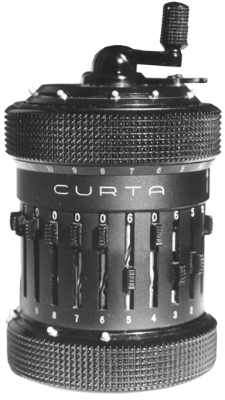01/05/2004:  Arcanum
Arcanum
The Curta Calculator
from A Curta Fan
Perhaps no calculator of any type has generated more discussion than the Curta. Although a book could be written on this incredible device and its inventor, I will limit this article to a very brief summary. In the future I'll discuss more details and explain how this wonderful machine actually works.
What is it? The Curta looks like a small metal pepper-mill or coffee grinder. It is, in fact, a precision instrument which performs calculations mechanically using no electric or electronic parts. I can best describe the sensation of turning the crank on a Curta as being similar to winding a fine 35mm camera. To the best of my knowledge it is the smallest mechanical calculating machine ever built.
Who invented it? Mr. Curt Herzstark of Austria.
How was it invented? Over the years I've heard rumors that Mr. Herzstark secretly developed the Curta while imprisoned in a German concentration camp. Apparently this is almost true. Herzstark was a prisoner at Buchenwald but the camp leaders were aware of his work and encouraged it. They apparently wanted to give the invention to the Fuehrer as a victory gift at the end of the war! Herzstark was given a drawing board and worked on the design day and night. The camp was liberated in April, 1945 by the Americans. Herzstark survived as did his revolutionary concept for a miniature calculator. (More details about how Curt Herzstark ended up in a concentration camp in a future issue.)
When were the Curtas made? Although several prototypes were made, the first production began in April, 1947. The last Curta was made in November, 1970 but they were still sold until early 1973. By then, pocket electronic calculators were selling for under $100 and a precision mechanical instrument like the Curta could no longer compete.
More
Try it out. Here is a Flash based Curta simulator:http://www.vcalc.net/curta_simulator_en.htm
If you need Flash, you can get it here:
http://www.macromedia.com/software/flashplayer
Here are a few excersises from the manual.
Multiplication:
54 x 3 = ?
1. Machine ready!
2. Setting register: with knob 1 set the "4" and with knob 2 set the "5": 54.
3. Handle: each turn of the handle transfers the set number once into the black dial (result dial). The multiplier 3 is therefore developed with 3 plus turns (lower or normal position of the handle), which will be registered in the white dial (counter dial).
Answer: Black dial: 162
Check: Setting dial: 54, White dial: 3
647 x 125 = ?
1. Machine ready!
2. Setting register: with knobs 1 to 3 set "647".
3. Handle: 5 plus turns. Looking at the white dial, you will notice that a 5 has been developed, which is the lowest digit of the number 125.
4. Carriage: position 2. In this carriage position each turn of the handle transfers the set number ten times into the black dial.
5. Handle: 2 plus turns. The white dial shows 25. The first two digits of the number 125 have now been developed.
6. Carriage: position 3 (hundreds digit).
7. Handle: 1 plus turn.
Answer: Black dial: 80875
Check: White dial: 125, Setting dial: 647
Addition:
237 + 419 = ?
1. Machine ready!
2. Setting register: with knobs 1 to 3 set "237".
3. Handle: 1 plus turn.
4. Setting register: with knobs 1 to 3 set "419". It is unnecessary to push back all the knobs to their zero position first. Merely adjust each knob until the required numbers appear in the setting dial.
5. Handle: 1 plus turn.
Answer: Black dial: 656
Check: White dial: 2, (Number of items added)
Subtraction:
139 - 78 = ?
1. Machine ready!
2. Setting register: with knobs 1 to 3 set "139".
3. Handle: 1 plus turn.
4. Setting register: with knobs 1 and 2 set 78; push knob 3 to zero position.
5. Handle: 1 minus turn (with handle in upper position).
Answer: Black dial: 61 *
* Remark: If a check of the number of items added and subtracted is required the reversing lever (see fig 8 front page) has to be moved into its lower position before doing a minus turn and moved back to its upper position for plus turns.
Division:
42 / 7 = ?
(Dividend) / (Divisor) = (Quotient)
The divisor 7 is set in the setting register and plus turns of the handle are made until the dividend 42 is built up in the black dial. The white dial registers each turn made. It indicates how often the divisor is contained in the dividend and thus shows the quotient.
1. Machine ready! (reversing lever in upper position!).
2. Setting register: with knob 1 set "7" (Divisor).
3. Handle: while watching the black dial make plus turns until the dividend 42 appears in the black dial. (If by doing a turn too many you overstep the required dividend, the black dial showing e. g. 49, you will have to make each time a minus turn immediately.)
As soon as the number 42 (dividend) appears in the black dial you can read off the quotient 6 in the white dial.
Answer: White dial: 6 (quotient)
Check: Black dial: 42 (dividend), Setting dial: 7 (divisor)


